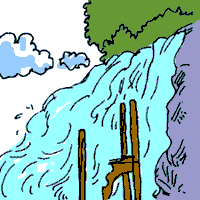
Dimdima
Online Children's Magazine from India

Dimdima
Online Children's Magazine from India
Thirty kilometres from Mekedatu, the Kaveri enters Tamil Nadu, and takes another mighty tumble, at Hogenakkal in the Thoppur Hills.  Hogenakkal means 'smoking stone'. The water falls down a height of 22 m into a yawning chasm. Thousands of people assemble to bathe here on the festival of Adit Padinattu or Adi Perakku, the 18th day of August. For the people of Tamil Nadu, the Kaveri river is Ponni, the golden one, especially beloved. The river has enriched not only the state's granaries, making it India's rice bowl, but permeated the Tamil culture in all its aspects�be it music, sculpture, temple architecture, literature or religion.
Hogenakkal means 'smoking stone'. The water falls down a height of 22 m into a yawning chasm. Thousands of people assemble to bathe here on the festival of Adit Padinattu or Adi Perakku, the 18th day of August. For the people of Tamil Nadu, the Kaveri river is Ponni, the golden one, especially beloved. The river has enriched not only the state's granaries, making it India's rice bowl, but permeated the Tamil culture in all its aspects�be it music, sculpture, temple architecture, literature or religion.
The Kaveri now flows more calmly, becoming wider. Right at the entrance point to the state, the waters are harnessed by the Mettur Dam, about 50 km downstream from Hogenakkal Falls. It was completed in a record six years. The dam in 1590 m long, 51 m wide and 64 m high. At the time of its construction, it was the largest masonry dam in the world and the reservoir created (Stanley Lake) was one of the largest man-made lakes covering about 60 sq km. A hydroelectric station at the toe of Mettur dam generates 36,000 kw of power.
Flowing southwards, the Kaveri meets the Bhavani river. The Bhavanisagar dam built here helps irrigate over 2 million acres.  The deity at the Bhavani Sangameshwara temple is believed to have miraculous powers. In the early 1900s, a British collector named Garro who lived near the temple was warned by the deity in a dream to vacate the house, just before a flood ravaged the area. A grateful Garrow gifted an ivory cradle to the temple.
The deity at the Bhavani Sangameshwara temple is believed to have miraculous powers. In the early 1900s, a British collector named Garro who lived near the temple was warned by the deity in a dream to vacate the house, just before a flood ravaged the area. A grateful Garrow gifted an ivory cradle to the temple.
The Kaveri moves on to Erode where two other major tributaries, the Amaravathi and the Noyyil join the river.
Last updated on :5/28/2021
Dimdima is the Sanskrit word for ‘drumbeat’. In olden days, victory in battle was heralded by the beat of drums or any important news to be conveyed to the people used to be accompanied with drumbeats.
Bharatiya Vidya Bhavan
K. M Munshi Marg,
Chowpatty, Mumbai - 400 007
email : editor@dimdima.com
Bharatiya Vidya Bhavan
505, Sane Guruji Marg,
Tardeo, Mumbai - 400 034
email : promo@dimdima.com
Dimdima.com, the Children's Website of Bharatiya Vidya Bhavan launched in 2000 and came out with a Printed version of Dimdima Magazine in 2004. At present the Printed Version have more than 35,000 subscribers from India and Abroad.